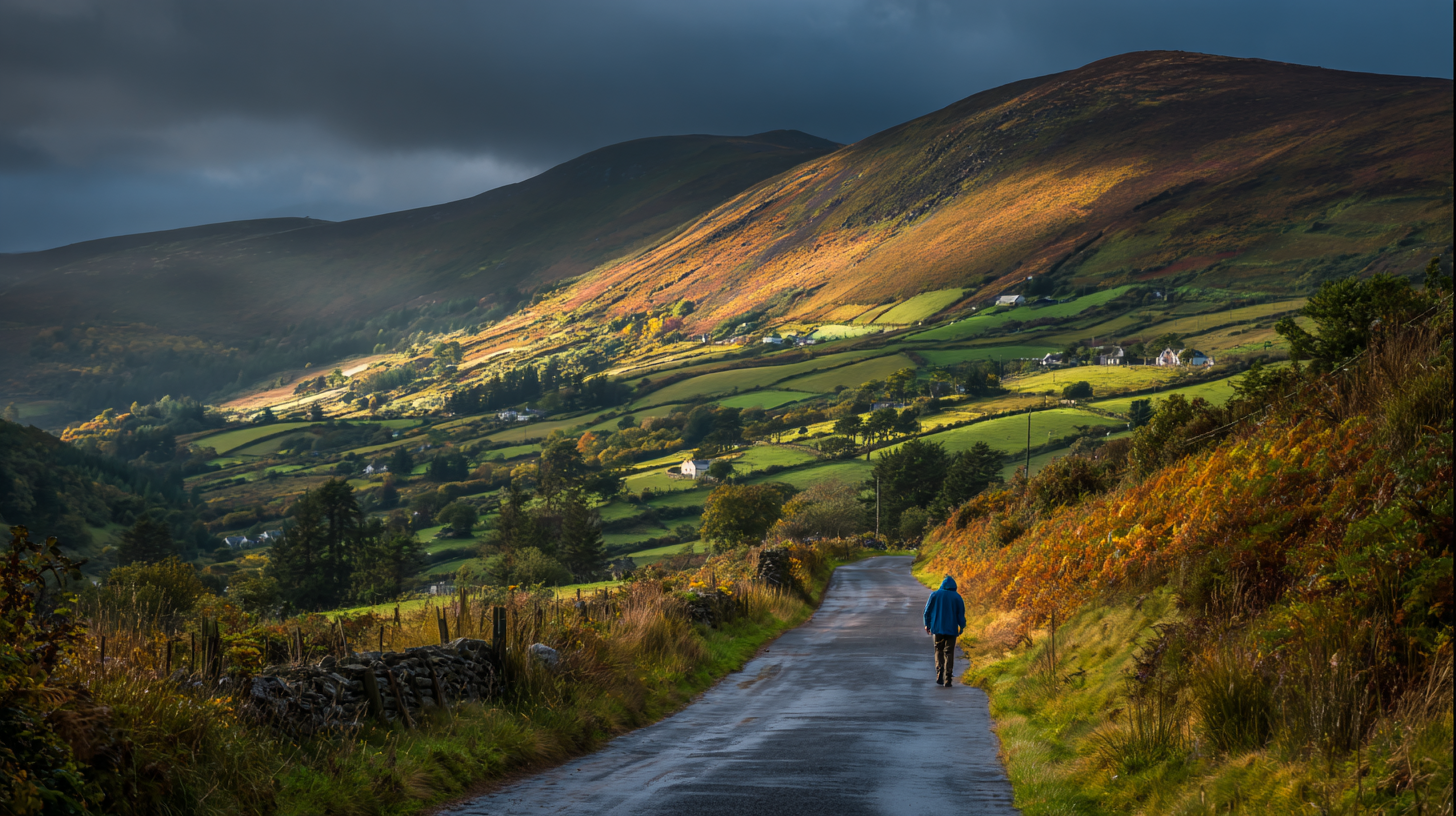Ireland in October unveils a spectacular display of autumn colors that transforms the Emerald Isle into a breathtaking tapestry of golden yellows, burnt oranges, and rich burgundies. As tourist numbers dwindle to their seasonal lows and the landscape dons its most dramatic autumn attire, knowing what to wear in Ireland in October becomes crucial for experiencing the country's raw beauty and authentic charm during this enchanting time of year. The weather during this quintessential autumn month presents unique challenges and opportunities, with crisp mornings giving way to mild afternoons, sudden rain showers, and early evening darkness that creates the perfect atmosphere for cozy pub gatherings. This comprehensive guide will equip you with everything you need to know about dressing appropriately for October's distinctive Irish weather conditions.
Understanding Ireland's October Weather
Ireland in October Weather Patterns
October marks Ireland's full transition into autumn, bringing weather patterns that are distinctly different from the milder conditions of early fall. The month represents a fascinating meteorological period where Atlantic weather systems become more active, creating conditions that can shift dramatically within hours. Understanding what to expect from Ireland's October weather forms the foundation for making intelligent clothing choices that will keep you comfortable throughout your Irish adventure.
The weather in Ireland in October typically features increased variability compared to September's more predictable conditions, with stronger winds, more frequent rain, and noticeably cooler temperatures becoming the norm. This month sees the Atlantic Ocean's influence intensify, bringing weather fronts that can transform a calm morning into a blustery afternoon. October's weather patterns are characterized by their unpredictability, where brilliant sunshine might suddenly give way to driving rain, only to clear again within minutes, creating that magical quality of light that Ireland is famous for.
Temperature Ranges and Daily Fluctuations
When planning what to wear in Ireland in October, understanding the temperature patterns becomes your first priority. Average temperatures during October typically range from 8°C to 14°C (46°F to 57°F), representing a noticeable drop from September's milder conditions. These averages, however, only tell part of the story, as October can deliver surprisingly warm Indian summer days alongside genuinely cold snaps that hint at the approaching winter.
During early October, daytime temperatures might still reach a pleasant 14°C to 16°C (57°F to 61°F), particularly during sunny spells that can make the autumn colors appear to glow. As the month progresses toward late October, temperatures steadily decline, with typical highs around 11°C to 13°C (52°F to 55°F) and nighttime lows dropping to 6°C to 9°C (43°F to 48°F). These cooler temperatures, combined with Ireland's persistent humidity, can create a penetrating chill that requires thoughtful layering strategies.
The daily temperature range in October becomes more pronounced than in early autumn months, with mornings often starting near freezing in inland areas, particularly in valleys where cold air settles overnight. This dramatic daily variation means that what feels comfortable at 2 PM might be woefully inadequate by 6 PM, especially as daylight savings time ends in late October, bringing earlier darkness and accelerating evening temperature drops.
Rainfall and Wind Considerations
October sees Ireland's rainfall patterns intensify, with average precipitation reaching 11 to 12 centimeters (4.3 to 4.7 inches) throughout the month. This increased rainfall, combined with stronger winds, creates conditions that demand more robust weather protection than September requires. Understanding October's rain patterns is essential for selecting appropriate waterproof clothing that can handle extended exposure to wet conditions.
The nature of October rain differs from summer showers, often arriving as persistent drizzle driven by strong Atlantic winds. These weather systems can bring hours of light but steady rain that has a remarkable ability to find its way through inadequate waterproofing. The combination of wind and rain creates horizontal precipitation that umbrellas struggle to deflect, making quality waterproof clothing absolutely essential for October travel in Ireland.
Wind becomes a significant factor in October's weather equation, with Atlantic storms beginning to influence Ireland's climate more frequently. Average wind speeds increase noticeably, particularly in coastal areas where gusts can exceed 60 kilometers per hour (37 mph). These winds not only drive rain but create substantial wind chill, making actual temperatures feel several degrees colder than thermometer readings suggest. This wind factor significantly impacts clothing choices, requiring windproof outer layers and secure fastenings that won't fail in gusty conditions.
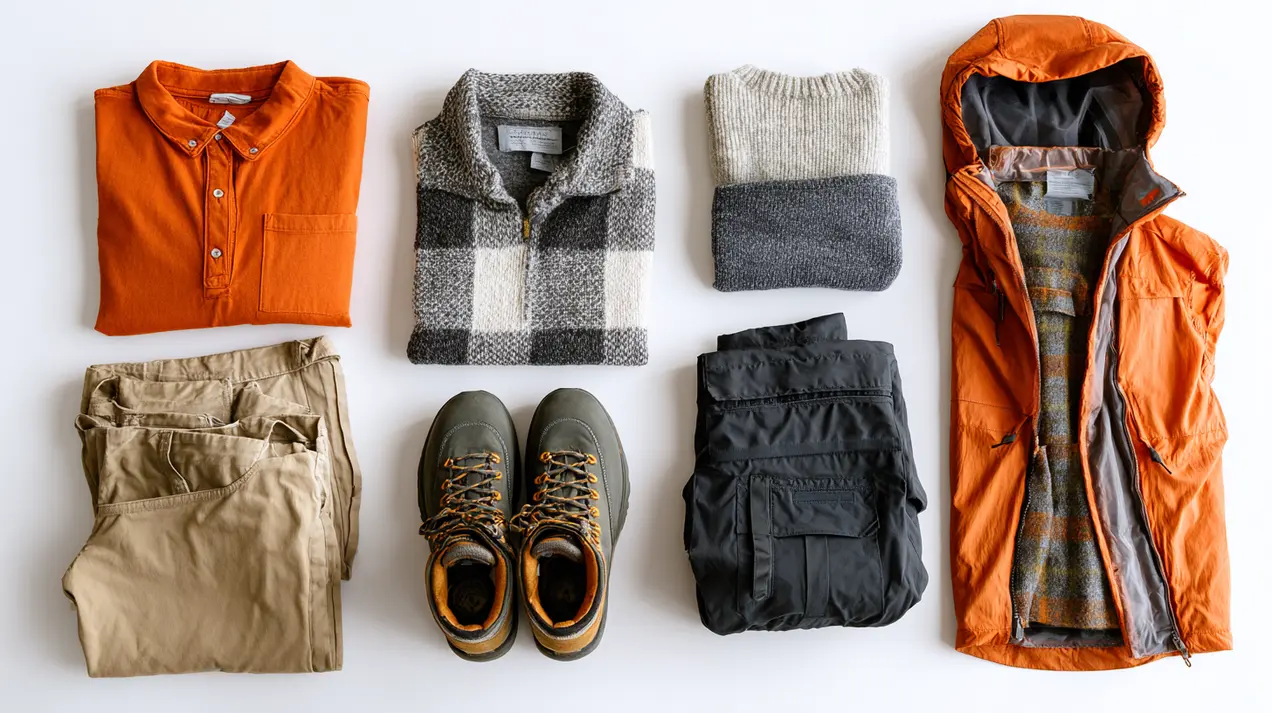
Essential Clothing Items for Ireland in October
The Foundation: Base Layers and Thermal Wear
When determining what to wear in Ireland in October, your base layer system becomes more critical than in warmer months. October's cooler temperatures and penetrating dampness require base layers that provide genuine warmth while managing moisture effectively. The foundation of your October wardrobe should prioritize thermal properties without sacrificing the breathability needed for active sightseeing.
Thermal underwear becomes a valuable addition to your October Ireland wardrobe, particularly for early morning starts and evening activities. Modern thermal wear has evolved far beyond the bulky long johns of the past, with sleek, comfortable options that provide surprising warmth without visible bulk under regular clothing. Merino wool thermals offer exceptional performance in Ireland's damp conditions, providing warmth even when slightly wet while naturally resisting odors during extended wear.
Long-sleeve base layer shirts should form the core of your October clothing system. Choose mid-weight options that provide more substantial warmth than September's lighter choices while remaining comfortable for indoor environments. These base layers should fit close to the body to trap warm air effectively but not so tight that they restrict circulation or layer uncomfortably under other clothing. Consider packing both crew neck and mock turtleneck styles for versatility in different weather conditions.
Mid-Layer Warmth: Sweaters, Fleeces, and Insulation
The mid-layer category takes on increased importance for what to wear in Ireland in October, as this layer provides the primary defense against autumn's chill. October's cooler temperatures demand more substantial mid-layers than earlier autumn months, with insulation becoming a key consideration alongside versatility and style.
Wool sweaters represent the quintessential Irish October garment, providing excellent warmth, traditional style, and practical functionality. Irish wool sweaters, including the famous Aran knits, offer superior insulation and water resistance due to wool's natural properties. These sweaters work beautifully in Ireland's damp October conditions, maintaining warmth even when exposed to mist or light rain. Choose sweaters in medium to heavy weights that can serve as standalone outer layers during dry periods or fit comfortably under waterproof shells during wet weather.
Fleece jackets provide modern alternatives to traditional wool, offering excellent warmth-to-weight ratios and superior moisture management. High-quality fleece maintains insulation properties when damp and dries quickly, making it ideal for Ireland's humid October conditions. Consider fleece jackets with wind-resistant panels or treatments, as October's increased winds can significantly reduce fleece's effectiveness without some wind protection.
Light insulated jackets become valuable additions for particularly cold October days or evening activities. Synthetic insulation performs better than down in Ireland's damp conditions, maintaining loft and warmth even when exposed to moisture. These jackets can serve as mid-layers under waterproof shells during very cold, wet conditions or as outer layers during dry, cold periods.
Outer Layer Protection: Robust Waterproofing
No discussion of what to wear in Ireland in October would be complete without emphasizing the critical importance of superior waterproof protection. October's increased rainfall and stronger winds demand more robust waterproofing than earlier autumn months, with quality and features becoming even more important for maintaining comfort during outdoor activities.
Your October waterproof jacket should prioritize durability and weather protection over packability. While September might allow for ultralight rain jackets, October's more challenging conditions require jackets with reinforced seams, substantial waterproof ratings, and design features that prevent wind-driven rain from penetrating. Look for jackets with storm flaps over zippers, adjustable cuffs with secure closures, and hoods with multiple adjustment points to maintain visibility in windy conditions.
Length becomes an important consideration for October waterproof jackets. Longer jackets provide better protection for your lower body, particularly important when October winds drive rain horizontally. Hip-length jackets work well for most activities, but three-quarter length options offer superior protection for extended outdoor exposure. Consider how the jacket length works with your planned activities and whether you'll be doing significant walking or hiking.
Waterproof pants deserve serious consideration for October Ireland travel, particularly if your itinerary includes substantial outdoor activities. Full waterproof pants provide complete protection during heavy rain, while waterproof over-pants can be worn over regular clothing when conditions deteriorate. Pack rain pants that are easy to put on and remove, as October's changeable weather might require multiple adjustments throughout the day.
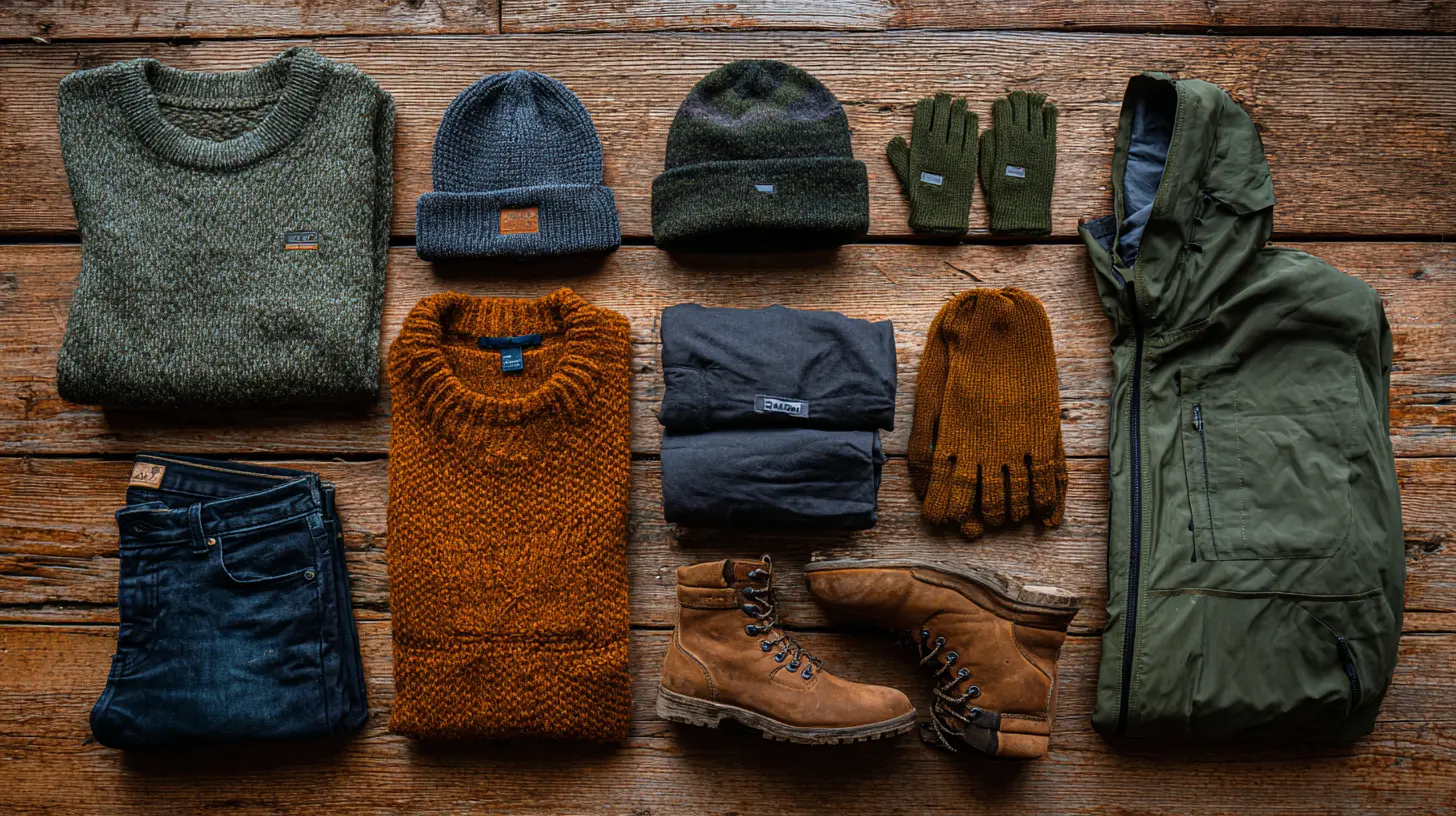
Bottom Wear: Pants and Weather Protection
Jeans and Heavier Trousers
Selecting appropriate bottom wear for what to wear in Ireland in October requires consideration of both warmth and weather resistance. October's cooler temperatures and increased precipitation make heavier weight pants essential, with water resistance becoming a valuable feature for maintaining comfort during outdoor activities.
Heavier weight jeans provide good protection against October's cool temperatures while maintaining the versatility needed for various activities. Choose jeans with minimal cotton content, as pure cotton denim becomes cold and uncomfortable when wet. Modern stretch denim blends that incorporate synthetic fibers offer better moisture management and faster drying times, important considerations for October's damp conditions.
Lined pants become valuable for October Ireland travel, providing additional warmth without the bulk of wearing multiple layers. Flannel-lined jeans or trousers offer excellent comfort during cold October days while maintaining a normal appearance suitable for restaurants and cultural sites. These lined options work particularly well for travelers who struggle with cold temperatures or plan extensive outdoor activities.
Water-resistant treatments for pants can significantly improve comfort during October's frequent rain showers. Many outdoor clothing manufacturers offer pants with durable water repellent (DWR) treatments that cause water to bead and roll off rather than soaking in. While not a substitute for full waterproof protection, these treatments can mean the difference between damp discomfort and staying reasonably dry during light rain.
Avoiding Shorts and Summer Wear
While September might occasionally allow for shorts, October in Ireland definitively marks the end of shorts weather for all but the hardiest travelers. October temperatures, combined with wind chill and frequent rain, make exposed legs uncomfortable and potentially unhealthy. Even on October's warmest days, the combination of cool mornings, evening chill, and unpredictable weather changes makes long pants the only practical choice.
Convertible pants that zip off into shorts provide no real advantage in October Ireland weather. The conditions that might momentarily feel warm enough for shorts can change within minutes, and the hassle of managing zip-off legs in wet, windy conditions outweighs any theoretical benefits. Focus instead on pants that provide consistent protection and comfort throughout the day.
Thermal underwear or base layer bottoms worn under regular pants provide a better solution for temperature management than attempting to wear shorts. These base layers can be added or removed as needed while maintaining appropriate coverage for October's conditions. This approach offers more flexibility and comfort than trying to manage exposed skin in Ireland's challenging October weather.
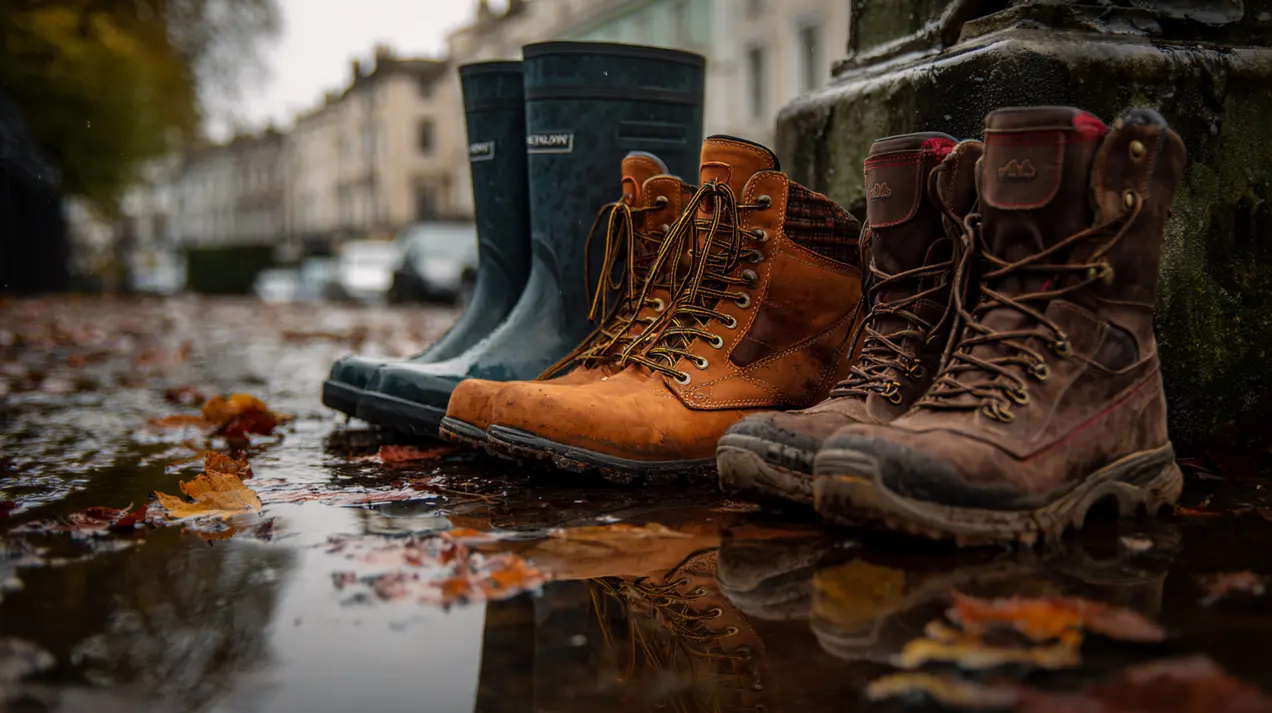
Footwear: Tackling October's Challenging Conditions
Waterproof Boots and Sturdy Shoes
Footwear selection becomes absolutely critical when planning what to wear in Ireland in October, as the combination of rain, wind, and cooler temperatures creates challenging conditions for your feet. October demands footwear that goes beyond the water-resistant shoes adequate for September, requiring genuine waterproof protection and robust construction.
Waterproof hiking boots represent the ideal footwear choice for October Ireland travel. These boots provide ankle support for uneven terrain, waterproof protection for wet conditions, and insulation for cooler temperatures. Look for boots with waterproof-breathable membranes that keep water out while allowing moisture from your feet to escape. The investment in quality waterproof boots pays dividends in comfort and health during October's challenging weather.
Mid-height boots offer the best balance of protection and comfort for October conditions. These boots provide adequate ankle support and protection from rain and puddles while remaining comfortable for extended walking. Ensure the boots are well broken-in before your trip, as October weather offers no mercy for dealing with blisters or foot discomfort caused by new footwear.
Traction becomes particularly important for October footwear, as wet leaves, mud, and slippery surfaces become common hazards. Choose boots or shoes with aggressive tread patterns that can maintain grip on various surfaces. Vibram or similar high-quality outsoles provide confidence on wet cobblestones, muddy paths, and leaf-covered trails that characterize October travel in Ireland.
Footwear Care and Backup Options
October's wet conditions require attention to footwear care and the necessity of backup options. Even quality waterproof boots can become overwhelmed by persistent rain, and having dry footwear available becomes essential for multi-day comfort during Ireland travel.
Pack a second pair of shoes that can serve as backup when your primary footwear needs drying time. Waterproof shoes or boots in a different style provide versatility while ensuring you always have dry footwear available. This backup pair might be slightly lighter or more casual than your primary boots, suitable for indoor activities or shorter walks during breaks in the weather.
Waterproofing treatments require regular reapplication during October travel, as constant exposure to rain degrades water repellent coatings. Pack a small bottle of waterproofing spray or cream appropriate for your footwear materials. Regular treatment, perhaps every few days during wet periods, maintains your footwear's protective properties throughout your trip.
Proper socks become even more critical in October's cold, wet conditions. Wool or synthetic blend socks provide warmth and moisture management superior to cotton options. Pack enough pairs to change daily, with extras for particularly wet days. Consider bringing different weights of socks to adjust warmth based on daily conditions and activity levels.
Mastering October Layering Strategies
Advanced Three-Layer System
The three-layer system becomes absolutely essential for what to wear in Ireland in October, requiring more sophisticated implementation than in warmer months. October's variable conditions demand careful attention to each layer's properties and how they work together to provide comfort across wide temperature and weather ranges.
Your October base layer must provide genuine warmth while maintaining moisture management capabilities. This isn't the time for ultralight summer base layers; October requires mid-weight or expedition-weight options that provide insulation even when damp. Merino wool base layers excel in October conditions, providing warmth, odor resistance, and comfort against the skin even during extended wear.
The mid-layer becomes your primary warmth provider in October, requiring more substantial insulation than September's lighter options. This layer should be easily adjustable, allowing you to regulate temperature as activity levels and weather conditions change. Consider wearing multiple thinner mid-layers that can be added or removed independently, providing more flexibility than a single heavy layer.
Your outer shell layer faces its biggest challenge in October, needing to protect against wind, rain, and cold while allowing the layering system underneath to function effectively. October shells should be roomier than summer options, accommodating substantial mid-layers without restricting movement. Ventilation becomes crucial, as the combination of warm layers and waterproof shells can quickly lead to overheating during active pursuits.
Dynamic Layering Adjustments
October's weather volatility requires constant attention to layering adjustments throughout the day. Morning preparations should account for near-freezing temperatures in some areas, with full layering systems deployed for early activities. As the day progresses, you might remove mid-layers during sunny spells, only to quickly re-add them when clouds arrive with accompanying temperature drops.
The shortened daylight hours of October create distinct layering phases throughout the day. Morning layers designed for cold starts might be excessive by midday, requiring removal and storage. However, October's early darkness means evening chill arrives while you're still actively exploring, requiring readily accessible warm layers that can be added without returning to accommodations.
Wind becomes a major factor in October layering decisions, as strong gusts can penetrate through layers that would be perfectly adequate in calm conditions. Wind-resistant mid-layers or wind-proof shell layers become essential, particularly for coastal activities or exposed locations. The ability to quickly add wind protection can mean the difference between comfortable exploration and miserable retreat to shelter.
Indoor-Outdoor Transitions
October travel involves frequent transitions between cold outdoor conditions and heated indoor spaces, requiring layering systems that can be quickly adjusted. Irish buildings often maintain warm interior temperatures to combat October's chill, potentially making full outdoor layering uncomfortably warm inside.
Plan your October layers with easy removal in mind, choosing pieces that can be quickly taken off and carried when entering shops, restaurants, or attractions. Front-zip mid-layers work better than pullovers for quick adjustments, and layers that pack small allow for easy storage in bags when not needed.
Consider the order of your layers for optimal adjustment flexibility. Wearing your most easily removed layers on the outside allows for quick temperature regulation without major wardrobe reconstruction. This might mean wearing a zip fleece over a sweater rather than under it, even if this isn't the thermally optimal arrangement.

Essential Accessories for October Weather
Head and Face Protection
Accessories take on increased importance for what to wear in Ireland in October, with head and face protection becoming essential rather than optional. October's wind and rain can make exposed skin genuinely uncomfortable, requiring comprehensive protection strategies.
Warm hats become absolutely essential for October Ireland travel. Wool or fleece beanies provide necessary insulation for cold mornings and windy conditions. Choose hats that cover your ears completely, as October winds can make exposed ears painfully cold. Pack at least two hats, ensuring you have a dry option available during extended wet periods.
Waterproof hat options deserve consideration for October's persistent rain. While hoods provide primary rain protection, a waterproof hat offers better visibility and ventilation than a hood while still protecting your head from rain. Baseball-style caps with waterproof treatment work well under jacket hoods, helping maintain visibility during rain.
Scarves or neck warmers provide crucial protection for the vulnerable neck area. October winds have an uncanny ability to find gaps between jacket collars and hats, making neck protection essential for comfort. Choose versatile options that can be adjusted for different conditions, from light coverage during mild periods to full wrapping during cold, windy weather.
Face protection might seem excessive, but October's wind-driven rain can make exposed facial skin genuinely uncomfortable. Buff-style neck gaiters can be pulled up to protect the lower face during particularly harsh conditions, while maintaining easy breathability when full coverage isn't needed.
Hand Protection and Gloves
Gloves transition from optional to essential accessories for Ireland in October. Cold morning temperatures, wind chill, and rain can make bare hands genuinely uncomfortable and potentially affect your ability to operate cameras, phones, or other devices.
Waterproof gloves provide the best protection for October conditions, keeping hands warm and dry during rain showers. However, fully waterproof gloves can lack dexterity and breathability. Consider carrying both waterproof mittens or gloves for harsh weather and lighter liner gloves for milder conditions or when dexterity is needed.
Touchscreen-compatible gloves have become essential for modern travel, allowing you to operate devices without exposing hands to cold, wet conditions. Many manufacturers now offer gloves with conductive fingertips that work effectively with smartphones and tablets. This feature proves invaluable for navigation, photography, and communication during October's challenging weather.
Spare gloves become important during October travel, as wet gloves take considerable time to dry in Ireland's humid conditions. Pack at least two pairs, ensuring you always have dry hand protection available. Lightweight liner gloves take minimal packing space and can serve as emergency backups if primary gloves become soaked.
Weather Protection Accessories
Additional weather protection accessories can significantly improve comfort during October's challenging conditions. These items might seem minor but can make substantial differences in your ability to enjoy outdoor activities despite difficult weather.
Gaiters provide valuable protection for the gap between boots and pants, preventing rain from running down into your footwear. October's horizontal rain and puddle-splashing conditions make gaiters particularly valuable for hiking or extended outdoor activities. Lightweight, packable gaiters take minimal luggage space but provide significant comfort improvement during wet conditions.
Waterproof pack covers protect your belongings during October's frequent rain showers. While many daypacks claim water resistance, October's persistent rain can overwhelm these defenses. A proper pack cover ensures your spare clothes, electronics, and other essentials remain dry regardless of weather conditions.
Emergency ponchos provide backup protection for unexpected severe weather. While not suitable as primary rain protection, a lightweight emergency poncho can provide additional coverage during particularly severe conditions or if primary waterproofing fails. These take minimal space and weight, making them worthwhile insurance for October travel.

Activity-Specific October Clothing
Urban October Exploration
Cities and towns require specific clothing considerations for October travel, balancing weather protection with the style expectations of urban environments. What to wear in Ireland in October for city exploration differs from rural activities, though weather protection remains paramount.
Dublin, Cork, and Galway's October weather can be particularly challenging due to urban wind tunnel effects. Buildings channel October winds, creating gusty conditions that can make umbrellas useless and require secure hat and hood systems. Choose clothing with minimal loose elements that could catch wind, and ensure all fastenings are secure and functional.
Shopping and dining present opportunities to warm up and dry off during October city exploration. Plan your routing to include regular indoor breaks where you can remove wet outer layers and warm up. This strategy influences clothing choices, favoring easily removable layers over complex systems that are difficult to manage in public spaces.
Evening socializing requires special consideration during October, as early darkness combines with cold temperatures to create challenging conditions for moving between venues. Plan evening outfits that maintain warmth during outdoor segments while being appropriate for Ireland's casual pub and restaurant atmosphere. Dark colors work well for hiding rain spots and maintaining a presentable appearance despite weather challenges.
Outdoor Adventures and Nature Activities
October presents unique challenges for outdoor activities in Ireland, with shorter days, challenging weather, and muddy conditions requiring specific clothing strategies. Hiking, photography, and nature observation all demand clothing that can handle extended exposure to October's elements.
Waterproof over-trousers become essential for serious outdoor activities in October. Full-zip sides allow for easy on-off without removing boots, crucial for responding to changing conditions. These over-trousers should be sized to fit over your regular pants and any base layers, with adequate ventilation to prevent overheating during active pursuits.
Extra insulation layers prove valuable for outdoor October activities, particularly for photography or wildlife observation that involves stationary periods. Insulated vests provide core warmth without restricting arm movement, ideal for active pursuits that require freedom of movement while maintaining warmth.
Safety considerations become more important during October outdoor activities. Shorter daylight hours mean you might find yourself outdoors as darkness falls. Include bright colors or reflective elements in your outer layers for visibility, and always carry a headlamp or torch for navigating in low light conditions.
Halloween and Special October Events
Ireland's Halloween traditions make October special, with celebrations that might influence your clothing needs. Understanding local customs and event requirements helps you prepare appropriately for these unique October experiences.
Halloween originated in Ireland as Samhain, and modern celebrations maintain special significance. If your October trip coincides with Halloween weekend, expect lively celebrations that might involve outdoor parades, bonfires, and extended evening activities. Extra warm layers become essential for participating in these outdoor celebrations that can extend late into cold October nights.
Autumn festivals and harvest celebrations occur throughout October, often involving outdoor elements regardless of weather. These events might require standing or sitting outdoors for extended periods, demanding clothing strategies that prioritize warmth and weather protection over style or convenience.
Consider packing one slightly nicer outfit suitable for special dinners or cultural events that might arise during October travel. While Ireland maintains a casual atmosphere, some October events or restaurants might appreciate slightly dressier attire. Choose pieces that can be dressed up with accessories while maintaining weather-appropriate properties.
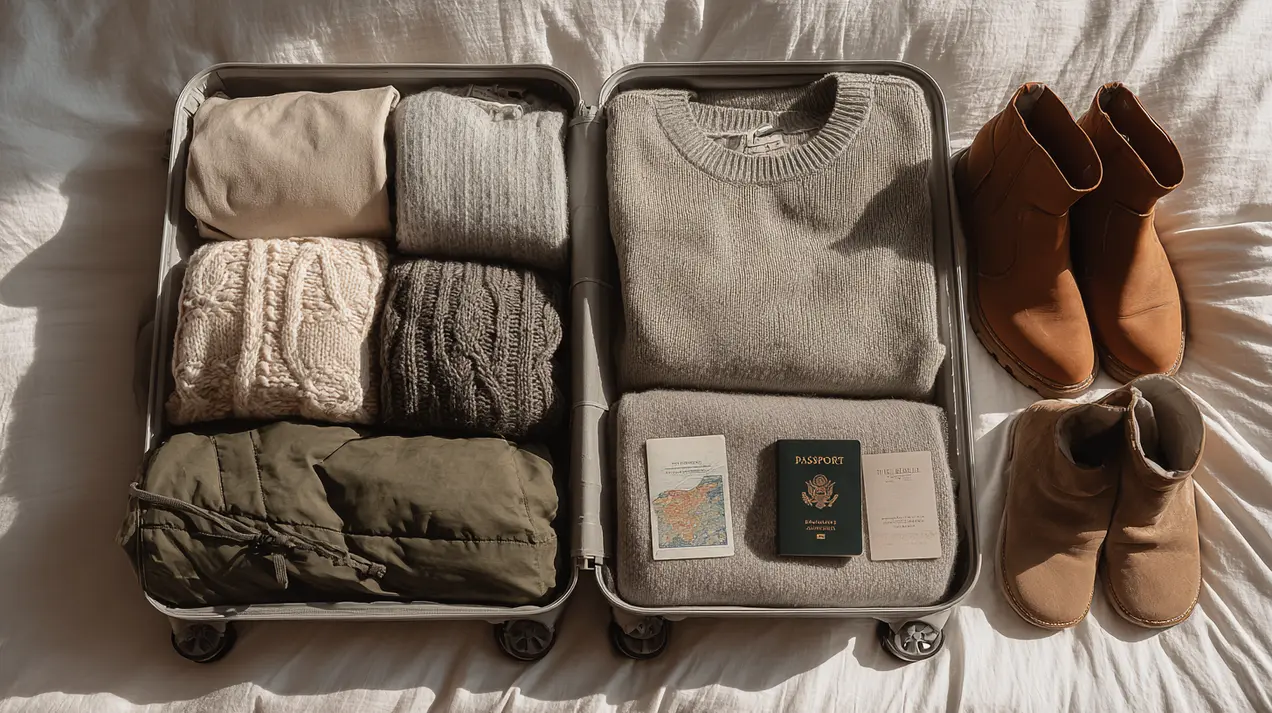
Packing Strategies for October Travel
Smart Packing for Cold Weather
Packing for what to wear in Ireland in October requires balancing comprehensive cold-weather preparation with luggage limitations. October's bulkier clothing items demand efficient packing strategies to fit everything needed without exceeding weight limits or sacrificing organization.
Compression bags become particularly valuable for October packing, as bulky sweaters and jackets can consume significant luggage space. These bags can reduce clothing volume by up to 50%, creating room for the additional layers October requires. Separate compression bags for different clothing categories maintain organization while maximizing space efficiency.
Wearing your bulkiest items during travel saves significant luggage space. Your waterproof jacket, heaviest boots, and thickest sweater can be worn on travel days, freeing luggage space for additional items. This strategy works particularly well for October travel, as airports and transportation are typically climate-controlled, making layers easy to manage.
Strategic color coordination becomes even more important with October's larger wardrobe requirements. Limiting your color palette to complementary shades means every piece works with others, maximizing outfit possibilities while minimizing total items needed. Dark colors work particularly well for October, hiding stains and maintaining appearance despite challenging weather.
Essential Items Checklist
Creating a comprehensive packing checklist ensures nothing essential is forgotten for October Ireland travel. This list should account for October's specific challenges while maintaining practical limitations.
Base layer essentials include thermal underwear tops and bottoms, multiple long-sleeve shirts, and sufficient undergarments for your trip length plus extras. October's damp conditions make having dry base layers crucial, so pack more than you might for dry-climate travel.
Mid-layer requirements encompass warm sweaters, fleece jackets, and possibly a light insulated jacket. Include both pullover and zip-front options for adjustment flexibility. Each mid-layer should work independently and in combination with others.
Outer protection must include a quality waterproof jacket, waterproof pants or over-trousers, and possibly a backup rain layer. October's challenging weather makes redundancy valuable for critical protective items.
Accessories shouldn't be overlooked: warm hats, waterproof gloves, scarves, and extra socks are all essential for October comfort. Pack multiples of easily lost items like gloves and hats.
October-Specific Considerations
Several factors unique to October influence packing decisions for Ireland travel. Understanding these considerations helps optimize your clothing selection for the specific challenges this month presents.
Daylight savings time ends in late October, suddenly making evenings much darker. Pack a small headlamp or torch for navigating in unexpected darkness, and consider reflective elements on outer clothing for safety during evening activities.
October's proximity to winter means weather systems can occasionally deliver unseasonably cold conditions. Include one extra warm layer beyond what average temperatures suggest, providing insurance against unexpected cold snaps that can occur as winter approaches.
Laundry becomes more challenging in October due to slower drying times in cold, humid conditions. Pack extra undergarments and socks to account for potentially limited laundry opportunities. Quick-dry fabrics become even more valuable when mechanical drying might be necessary.
Halloween week can affect accommodation availability and prices in popular areas. If traveling during this period, book accommodations well in advance and be prepared for livelier nighttime atmospheres that might influence your evening clothing needs.

Regional October Variations
Western Ireland's Atlantic Challenge
Western Ireland faces the full force of Atlantic weather systems in October, creating some of the most challenging conditions you'll encounter. Understanding these regional specifics helps prepare appropriate clothing for coastal exploration.
Atlantic storms begin affecting western Ireland more frequently in October, bringing intense wind and rain combinations. Coastal areas like the Cliffs of Moher, Dingle Peninsula, and Connemara can experience winds exceeding 80 kilometers per hour (50 mph) during storm systems. Your clothing must withstand these conditions while maintaining functionality for sightseeing and photography.
The Wild Atlantic Way becomes particularly wild in October, with dramatic seas and weather creating spectacular but challenging conditions. Waterproof protection must be absolutely reliable, as coastal spray adds to rainfall in creating wet conditions. Choose clothing with sealed seams and storm flaps that can handle horizontal rain driven by fierce coastal winds.
Despite challenging weather, western Ireland offers some of October's most dramatic experiences. Proper clothing allows you to witness powerful Atlantic storms, dramatic lighting, and seascapes at their most impressive. The investment in quality weather protection pays dividends in enabling these unforgettable experiences.
Eastern Ireland and Dublin Region
Eastern Ireland generally experiences slightly milder October conditions than western regions, though urban environments create their own challenges. Dublin and surrounding areas benefit from some shelter from Atlantic systems but still require comprehensive October clothing preparation.
Dublin's October weather often features less rainfall than western areas but can deliver surprisingly cold conditions due to continental influences. Eastern cold snaps can bring near-freezing temperatures that feel particularly harsh in urban environments where wind channeling between buildings creates additional chill factors.
Urban heat islands provide minimal benefit in October, unlike summer months. While cities might be slightly warmer than surrounding countryside, the difference becomes negligible during October's cooler conditions. Don't expect Dublin's urban environment to provide significant warmth advantage over rural areas.
The Dublin Mountains and Wicklow Mountains can experience significantly harsher October conditions than nearby cities. If your itinerary includes hiking in these areas, prepare for mountain weather that might include frost, strong winds, and rapidly changing conditions requiring full winter-capable clothing.
Northern Regions and Special Considerations
Northern Ireland and the northern Republic counties experience October's earliest winter-like conditions. These regions require clothing preparation approaching winter standards, particularly late in the month.
The Causeway Coast faces harsh October conditions, with north Atlantic exposure creating challenging weather for visiting attractions like Giant's Causeway or Carrick-a-Rede rope bridge. Wind protection becomes absolutely critical, with waterproofing essential for comfort during coastal exploration.
Mountainous areas like the Mournes or Donegal highlands can experience frost and occasionally snow in late October. If visiting these regions, include genuine winter layers including insulated jackets, winter-weight base layers, and possibly light gloves and warm hats suitable for near-freezing conditions.
Rural areas in northern regions might have limited shopping facilities for forgotten items. Unlike Dublin or Cork where clothing stores abound, northern rural areas require complete preparation before arrival. Don't count on purchasing forgotten items during your journey through these regions.

Conclusion: Embracing Ireland's Dramatic October Beauty
Understanding what to wear in Ireland in October unlocks access to one of the country's most atmospheric and authentic travel periods. October showcases Ireland at its most dramatic, with stunning autumn colors, powerful Atlantic storms, and cozy pub atmospheres that define the Irish experience. Proper clothing preparation transforms October's challenging weather from an obstacle into an integral part of your Irish adventure.
The key to October success lies in respecting the weather's power while preparing comprehensively for its challenges. Quality waterproof protection, effective layering systems, and warm accessories aren't just comfort enhancers—they're essential tools that enable you to experience Ireland's October magic fully. From witnessing Atlantic storms crashing against ancient cliffs to enjoying traditional music in warm pubs while rain lashes windows, proper clothing makes these experiences possible and enjoyable.
Remember that October rewards the prepared traveler with uncrowded attractions, authentic local experiences, and dramatic natural beauty that photographers dream about. The investment in appropriate clothing—from waterproof boots that handle muddy paths to warm layers that combat Atlantic winds—pays dividends in comfort and capability throughout your journey.
Our years of experience helping travelers prepare for October adventures have shown that those who respect the weather and dress accordingly consistently have the most memorable experiences. The ability to remain warm and dry while exploring Ireland's October landscape allows you to focus on the incredible history, culture, and natural beauty surrounding you rather than physical discomfort.
As you prepare for your October journey to Ireland, embrace the month's challenges as part of its charm. The same weather that demands careful clothing preparation creates the dramatic skies, powerful seas, and mystical atmospheres that make October Ireland truly special. With the comprehensive clothing strategies outlined in this guide, you're ready to experience everything this remarkable month offers.
Planning your October adventure? Consider exploring Ireland's highlights in just five days to make the most of your autumn journey to the Emerald Isle.
FAQs: What to Wear in Ireland in October
Is October too cold to visit Ireland?
October is not too cold to visit Ireland, with temperatures typically ranging from 8°C to 14°C (46°F to 57°F). While cooler than summer months, proper clothing makes October comfortable and enjoyable. The key is preparing for wind, rain, and temperature variations with appropriate layers and waterproof protection. Many travelers prefer October's crisp weather and dramatic atmospheres to busier, warmer months.
Do I need winter clothes for October in Ireland?
You don't need full winter gear, but October requires substantial cold-weather clothing. Pack warm layers including sweaters, fleece jackets, and possibly a light insulated jacket. Waterproof outer layers are essential, as are warm accessories like hats and gloves. Think "cold autumn" rather than "winter" when selecting clothes—you need warmth and weather protection but not heavy winter coats or snow boots.
What type of jacket is best for Ireland in October?
A high-quality waterproof jacket with a hood is essential for October in Ireland. Choose jackets with sealed seams, storm flaps over zippers, and adjustable cuffs and hoods. The jacket should be roomy enough to accommodate warm layers underneath. Breathability is important to prevent overheating during active pursuits. Consider longer jackets for better protection against wind-driven rain.
Should I bring waterproof pants for October?
Yes, waterproof pants or over-trousers are highly recommended for October in Ireland. October's increased rainfall and wind make waterproof leg protection valuable, especially for outdoor activities. Full-zip sides allow for easy on-off over boots. Even if you don't use them daily, having waterproof pants available provides important backup for severe weather days.
Are hiking boots necessary for October in Ireland?
Waterproof hiking boots are strongly recommended for October in Ireland. They provide ankle support, waterproof protection, and traction on wet, muddy, or leaf-covered surfaces. Regular shoes struggle with October's wet conditions and muddy paths. If you only bring one pair of footwear, waterproof hiking boots offer the best versatility for October conditions.
How many layers should I wear in October?
Plan for a full three-layer system in October: thermal base layer, insulating mid-layer (or multiple light mid-layers), and waterproof outer shell. Mornings might require all layers, while midday might allow for removing the mid-layer. The ability to adjust layers throughout the day is crucial for October comfort. Always carry removed layers with you as weather can change quickly.
What fabrics work best for October in Ireland?
Merino wool and synthetic materials work best for October's damp, cool conditions. These fabrics maintain warmth when wet and dry relatively quickly. Avoid cotton, especially for base layers, as it loses insulation when wet and dries slowly. Fleece provides excellent warmth-to-weight ratio for mid-layers. Ensure outer layers are genuinely waterproof, not just water-resistant.
Can I do laundry easily during October travel?
Laundry facilities are available, but October's humid conditions mean clothes dry slowly. Pack extra undergarments and socks to reduce laundry frequency. Choose quick-dry fabrics when possible. If using launderettes, expect to use dryers rather than air-drying. Many accommodations offer laundry services, though drying times might be extended compared to summer months.
Is October a good time to visit Ireland?
October is an excellent time to visit Ireland for travelers who appreciate dramatic weather, autumn colors, and authentic experiences. Tourist sites are uncrowded, accommodation prices drop, and locals have more time for genuine interactions. The weather requires preparation, but October rewards properly equipped travelers with some of Ireland's most memorable and atmospheric experiences.
What's the biggest mistake people make with October clothing?
The most common mistake is underestimating wind and rain intensity while overestimating temperature needs. Many visitors pack for cold but dry conditions, bringing warm clothes without adequate waterproofing. October requires excellent rain protection first, warmth second. Another mistake is not bringing enough accessories—hats, gloves, and scarves make huge comfort differences in October conditions.

